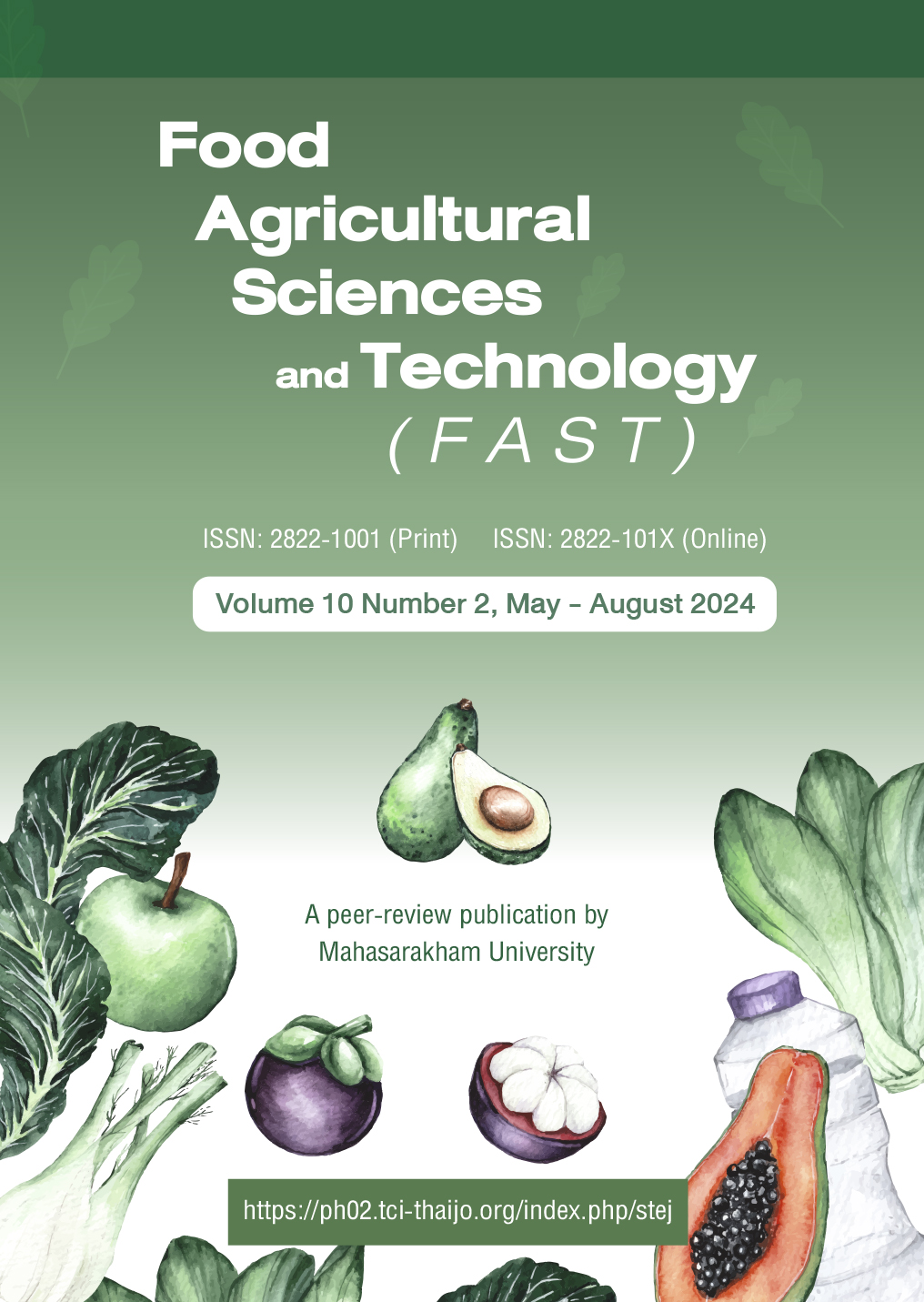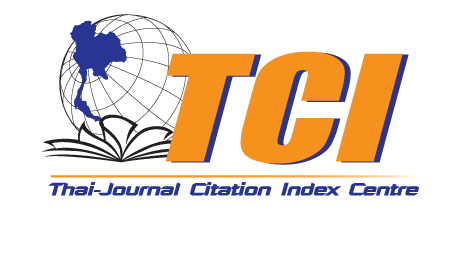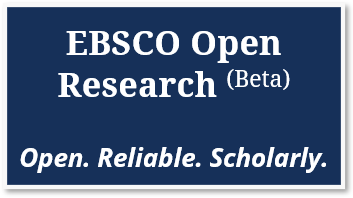Effects of enrichment on faecal corticosterone and stereotypic behaviour of sloth bears (Melursus ursinus) in captivity at Chiang Mai Night Safari
Keywords:
Stereotypic behaviour, corticosterone, enrichment, sloth bear (Melursus ursinus)Abstract
Corticosterone is a hormone that responds to the level of stress in animals and to their stereotypic behaviour. In wildlife and captive animals, organising activities for behaviour enrichment and improvement of animal welfare and quality of life is necessary. This study aimed to investigate the effects on stereotypic behaviours associated with behaviour enrichment on the levels of corticosterone in faeces and the correlation between faecal corticosterone and stereotypic behaviours in captive sloth bears. The five sloth bears used were captive at Chiang Mai Night Safari. Data were collected in three periods: before, during, and after the behaviour enrichment. The faeces were collected individually to determine corticosterone using enzyme-immunoassay (EIA). Repetitive pacing in the same area was observed as stereotypic behaviour. The results showed that individual faecal corticosterone levels and the stereotypic behaviour of the sloth bears before and during the behaviour enrichment period were significantly different (P<0.05). Stereotypic behaviour was statistically significantly different before, during, and after the behaviour enrichment (P<0.05). Additionally, the correlation between the amount of faecal corticosterone and stereotypic behaviour was calculated using Pearson’s correlation coefficient and found to be statistically significantly related (P<0.05). This study provides basic information about the effect of enrichment on faecal corticosterone and the stereotypic behaviour of captive sloth bears.
References
Abdul-Mawah, SS., Chor-Wai, L., Jasnie, F., Norma-Rashid, Y., & Ramli, R. (2022). Effects of environmental enrichment on behaviours and faecal glucocorticoid levels in captive sun bear (Helarctus malayanus). InIOP Conference Series: Earth and Environmental Science, 1019(1), 012016. doi:10.1088/1755-1315/1019/ 1/012016
Carlstead, K. & Seidensticker, J. (1991). Seasonal variation in stereotypic pacing in an American black bear (Ursus americanus). Behavioural Processes, 25(2-3), 155-161. https://doi.org/10.1016/0376-6357 (91)90017-T
Carlstead, K. & Shepherdson, D. (1994). Effects of environmental enrichment on reproduction. Zoo Biology, 13, 447 - 458.
Carlstead, K. (1996). Effects of captivity on the behaviour of wild mammals. The University of Chicago Press.
Carlstead, K. (1998). Determining the causes of stereotypic behaviours in zoo carnivores. Smithsonian Institution Press.
Clubb, R. & Mason, G. J. (2007). Natural behavioural biology as a risk factor in carnivore welfare: How analysing species differences could help zoos improve enclosures. Applied Animal Behaviour Science, 102, 303-328. https://doi.org/10.1016/j. applanim.2006.05.033
Dantzer, R. (1991). Stress, stereotypies and welfare. Behavioural Processes, 25(2 - 3), 95 -102. https://doi. org/10.1016/0376-6357(91)90012-o
Dharaiya, N., Bargali, H.S. & Sharp, T. (2016). Melursus ursinus. The IUCN Red List of Threatened Species. http:// dx.doi.org/10.2305/IUCN.UK.20163. RLTS.T13143A45033815.en
Düpjan, S. & Puppe, B. (2016). Abnormal behaviour with a focus on stereotypies- indicators of suffering and impaired welfare?. Berliner und Münchener Tierärztliche Wochenschrift, 129 (3 - 4), 93 - 102. https://doi.org/ 10.1016/S0003-3472(05)80640-2
Keay, J. M., Singh, J., Gaunt, M. C., & Kaur, T. (2006). Faecal glucocorticoids and their metabolites as indicators of stress in various mammalian species: A literature review. Journal of Zoo and Wildlife Medicine, 37(3), 234 - 244. https:// doi.org/10.1638/05-050.
Kosaruk, W., Brown, JL., Plangsangmas, T., Towiboon, P., Punyapornwithaya, V., & Silva-Fletcher, A. (2020). Effect of tourist activities on faecal and salivary glucocorticoids and immunoglobulin a in female captive Asian elephants in Thailand. Animals, 10(10), 1928. https://doi. org/10.3390/ani10101928
Lafferty, DJ., Laudenslager, ML., Mowat, G., Heard, D., & Belant, JL. (2015). Sex, diet, and the social environment: factors influencing hair cortisol concentration in free-ranging black bears (Ursus americanus). PLoS One, 10(11), e0141489. https://doi.org/10.1371/ journal.pone.0141489
Liu, D., Wang, ZP., Tian, H., Yu, CQ., Zhang, GQ., Wei, RP., Zhang, HM. (2003). Behavior of giant pandas (Ailuropoda melanoleuca) in captive conditions: Gender differences and enclosure effects. Zoo Biology, 22, 77 - 82. https:// doi.org/10.1002/zoo.10076
Manteca, X. & Salas, M. (2015). Stereotypies as animal welfare indicator: Zoo animal welfare fact sheet. https:// www.zawec.org/media/com_lazypdf/ pdf/Sheet%20ZAWEC%202%20.pdf
Martin, L. B. (2009). Stress and immunity in wild vertebrates: timing is everything. General and Comparative Endocrinology, 163, 70 - 76. https:// doi.org/10.1016/j.ygcen.2009. 03.008
Mason, G. (1991). Stereotypies: A critical revices. Animal Behaviour, 41(6), 1015 - 1037.
Mason, G., Clubb, R., Latham, N., & Vickery, S. (2007). Why and how should we use environmental enrichment to tackle stereotypic behaviour?. Applied Animal Behaviour Science, 102, 163-188. https://doi. org/10.1016/j.applanim.2006.05.041
Mason, GJ. & Latham, NR. (2004). Can’t stop, won’t stop: is stereotypy a reliable animal welfare indicator?. Animal Welfare, 13, S57-S69. https://doi. org/10.1017/S096272860001438X
McPhee, M. E. & Carlstead, K. (2010). Wild mammals in captivity (2nd ed.) University of Chicago Press.
Montaudouin, S. & Le Pape, G. (2004). Comparison of the behaviour of European brown bears (Ursus arctos arctos) in six different parks, with particular attention to stereotypies. Behavioural Processes, 67(2), 235-244. https://doi.org/10.1016/j. beproc.2004.02.008
Morgan, K. N. & Tromborg, C. T. (2007). Sources of stress in captivity. Applied Animal Behaviour Science, 102(3), 262-302.
Owen, M. A., Swaisgood, R. R., Czekala, N. M., & Lindburg, D. G. (2005). Enclosure choice and well-being in giant pandas: is it all about control?. Zoo Biology, 24(5), 475 - 481. https://doi.org/10.1002/zoo.20064
Owen, M. A., Swaisgood, R. R., Czekala, N. M., Steinman, K., & Lindburg, D. G. (2004). Monitoring stress in captive giant pandas (Ailuropoda melanoleuca): Behavioral and hormonal responses to ambient noise. Zoo Biology, 23(2), 147 - 164. https://doi.org/10.1002/zoo.10124
Pastorino, G.Q., Cartwright, R., Brereton, J.E., Wilkins, K. & Preziosi, R., (2021). The challenges of using camera traps to investigate zoo-housed polar bear (Ursus maritimus) nocturnal behaviour. Journal of Veterinary Medicine and Animal Sciences, 4(2), 1080.
Prater, D. L. (1965). The book of Indian mammals. Oxford University Press. Robert, A. (2009). Captive breeding genetics and reintroduction success. Biological Conservation, 142(12), 2915 - 2922. https://doi.org/10.1016/j. biocon.2009.07.016
Sapolsky, R. M. (2002). Endocrinology of the stress - response. behavioural endocrinology (2nd ed.). MIT Press.
Shepherdson, D. J. (1998). Tracing the path of environmental enrichment in zoos. Smithsonian Institution Press.
Shepherdson, D. J., Carlstead, K., Mellen, J. D., & Seidensticker, J. (1993). The influence of food presentation on the behavior of small cats in confined environments. Zoo Biology, 12(2), 203 - 216. https:// doi.org/10.1002/zoo.1430120206
Shepherdson, D. J., Lewis, KD., Carlstead, K., Bauman, J., & Perrin, N. (2013) Individual and environmental factors associated with stereotypic behavior and faecal glucocorticoid metabolite levels in zoo housed polar bears. Applied Animal Behaviour Science, 147, 268-277. https://doi. org/10.1016/j.applanim.2013.01.001
Sheriff, M. J., Dantzer, B., Delehanty, B., Palme, R. & Boonstra, R. (2011). Measuring stress in wildlife: techniques for quantifying glucocorticoids. Oecologia, 166(4), 869-887. https://doi.org/10.1007/ s00442-011-1943-y
Shih, H., Yu, J., & Wang, L. (2016). Stereotypic behaviours in bears. Taiwan Veterinary Journal, 42(1), 11 - 17. https://doi.org/10.1142/ S168264851530004X
Swaisgood, R.R., White, A.M., Zhou, X.P., Zhang, H.M., Zhang, G.Q., Wei, R.P., Hare, V.J., Tepper, E.M., & Lindburg, D.G. (2001). A quantitative assessment of the efficacy of an environmental enrichment program for giant pandas. Animal Behaviour, 61(2), 447 - 457. https:// doi.org/10.1006/anbe.2000.1610
Vickery, S. & Mason, G. (2004). Stereotypic behavior in Asiatic black and Malayan sun bears. Zoo Biology, 23 (5), 409 - 430. https://doi. org/10.1002/zoo.20027
Von der Ohe, CG., Wasser, SK., Hunt, KE., & Servheen, C. (2004). Factors associated with faecal glucocorticoids in Alaskan brown bears (Ursus arctos horribilis). Physiological and Biochemical Zoology, 77(2), 313-20. https:// doi.org/10.1086/378139
Wasser, S. K., Hunt, K. E., Brown, J., Cooper, K., Crockett, C. M., Bechert, U. & Monfort, S. L. (2000). A generalized faecal glucocorticoid assay for use in a diverse array of nondomestic mammalian and avian species. General and Comparative Endocrinology, 120(3), 260 - 275. https://doi.org/10.1006/gcen. 2000.7557
Young, K. M., Walker, S. L., Lanthier, C., Waddell, W. T., Monfort, S. L., & Brown, JL. (2004). Noninvasive monitoring of adrenocortical activity in carnivores by faecal glucocorticoid analyses. General and Comparative Endocrinology, 137(2), 148 - 165. https://doi. org/10.1016/j.ygcen.2004.02.016
Zhang, L., Guo, W., Lv, C., Guo, M., Yang, M., Fu, Q., & Liu, X. (2023). Advancements in artificial intelligence technology for improving animal welfare: Current applications and research progress. Animal Research and One Health, 2(1),93 - 109. https://doi. org/10.1002/aro2.44
Zhou, W., Gao, K., Ma, Y., Wang, L., Wang, M., Wei, F., & Nie, Y. (2020). Seasonal dynamics of parasitism and stress physiology in wild giant pandas. Conservation Physiology, 8(1), 1 - 12. https://iopscience.iop.org/ article/10.1088/1755-1315/1019/ 1/012016
Zoumin, E., Mawah, SS., Wai, LC., & Jasnie, F. (2023). Study of faecal glucocorticoid metabolite in bears: a review. Malaysian Journal of Science, 42(1), 92-105. https:// doi.org/10.22452/mjs.vol42no1.9
Downloads
Published
How to Cite
Issue
Section
License
Copyright (c) 2024 Food Agricultural Sciences and Technology

This work is licensed under a Creative Commons Attribution-NoDerivatives 4.0 International License.







